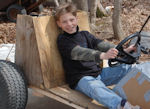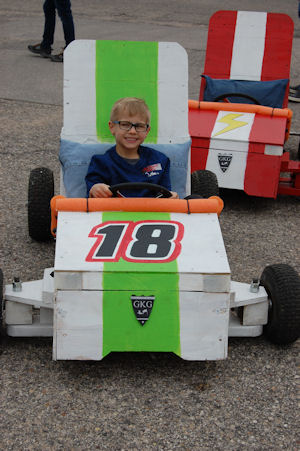The ambitious go karter had this grand vision of a go kart that would do all sorts of things. It would hold four kids, have a vertical engine, be made out of wood, used lawnmower wheels, and go 10 miles an hour. It started to turned into a mini behemoth as more and more boards were being tacked onto this go kart platform.
In the final hours of the go kart experience the go kart was test driven using a tractor. A lawnmower tractor that is, that pulled on the go kart down the driveway. All three kids piled into this go kart and proceeded down the driveway at a very slow rate as the tractor slowly pulled them along. Then things started to happen. Go kart wheels started to fall apart and break up. The rubber on the rims of the wheels literally peeled off and fell off. All four wheels were down to the metal rims and the rubber had fallen off of the rims on the go kart.
What happened here?
What happened here is that the go kart was over weight by at least 200 pounds, and the idea that being able to use a puny little lawnmower engine to get the go kart to even move was not plausible at all. The wheels themselves demonstrated that the go kart weighed too much.
What were sare seeing here is a typical non-planned go kart, one where the idea the picture of a go kart is in one’s mind but the actual practice or practical application of it is out of one’s grasp.
I ran into that a lot when I was a kid. And this is where somebody who can instruct or a good book like the books that we provide in the Go Kart Guru series can help a lot with that.
For example having a go kart be overweight can easily be remedied by doing a drive system diagnostic. Using the go kart guru program that is provided on the Go Kart Guru website you can tell whether or not the engines going to be able to pull the go kart or not. Secondly in the go kart building series, where we show you how to put together a frame, weight is a very large consideration for strength of the frame and size of a components such as wheels, drive gears bearings, steering systems and so forth.
This go kart that was in the story, was a wood go kart, however, it lacked good design considerations. The assumption was made that the go kart could be just built up from the platform was put together and no consequences would result. The result was obviously way too much weight. As a side note, using lawnmower wheels that come off of lawnmowers typically will not work on a go kart because they don’t have:
1.) Bearings that are designed to travel much faster than 1 mile an hour and
2.) The rims themselves are not designed to carry a lot of load.
3.) The wheels themselves and not designed to take a sideload such as cornering. The wheel will break or twist.
A rim that is needed for a go kart needs to be something that comes off a riding tractor or a go kart wheel that is actually designed for go karting.
And finally, beware of bearings that are pressed together, they don’t last very long because they are not designed to take sideload. See the article on pressed together bearings for a better grasp on this subject.
When you’re designing a go kart you need to keep in mind obviously the weight and the horsepower. One of the major misconceptions by go kart builders is that they think they can just slap on a really big motor and use actually a really large clutch, but they can use a smaller drive here and not suffer the consequences of smoking clutch.
A smoking clutch is a problem related to clutch engagement and the RPMs of the engine. On larger engines for example you may get a clutch that is rated at 24 horsepower, however it is designed to engage at 2000 RPMs and may slip at that RPM because engagements is supposed to occur.
In order to get the clutch to grab more the spring rate on the clutch needs to be lessened otherwise the clutch will just slip at that 2000 RPMs. You need to exceed the 2000 RPMs probably up to like 4000 rpms in order to get it to grab well and then continue on. Typically what you will have is a go kart that has a governor that will not allow the engine to go beyond 3600 RPMs and therefore may cause the clutch to smoke
As a rule of thumb the go kart should not weigh more than 150 to 200 pounds, and the engine size does not need to be much larger than eight horsepower. You will get decent performance out of the go kart at most inclines up to about 10° (which is a typical hill) and you will get really good straight-line performance as well. The ratio of the engine to the rear wheels should be around 10 to 1.
And as a final note the rule of thumb for rear drive sprockets is that they be close to the diameter of the rear wheel.
For more information about go kart drives systems, go kart steering systems, go kart braking systems, go kart frame design and much more, visit the go kart guru bundle, where you will get 9 ebooks, plus go kart plans for free.


